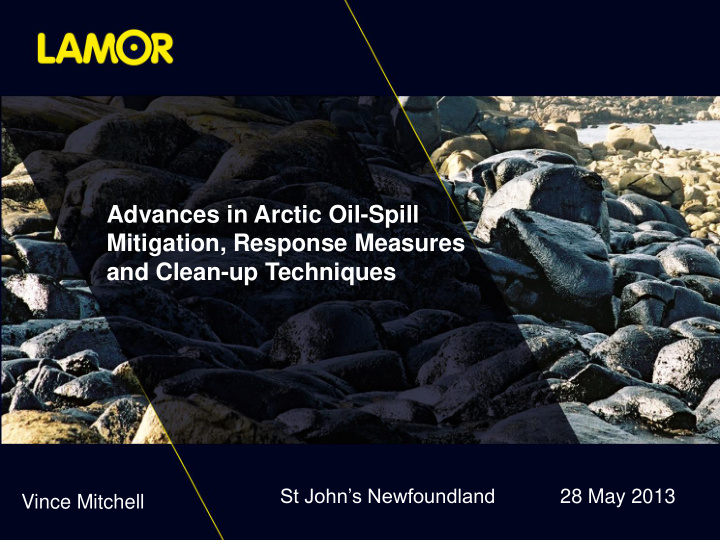



Advances in Arctic Oil-Spill Mitigation, Response Measures and Clean-up Techniques St John’s Newfoundland 28 May 2013 Vince Mitchell
Looking Forward LNXG 1000 Skimming System Animation
Present day status Unprecedented seasonal retreat of sea ice in the Arctic is occurring This will drastically increase the amount of worldwide marine activity in the arctic Including an increase in shipping of all types of vessels, oil and gas exploration, development and production activities SO This presents new considerations and challenges for arctic nations as the chances increase of oil being spilled in these regions of both persistent oils and non persistent oils
Behavior of spilled oil Behavior of any oil spilled in arctic conditions is different than oil spilled in more temperate regions The arctic conditions and especially the presence of ice create conditions that may be favorable or unfavorable for spilled oil recovery operations Less Evaporation Less Spreading Increased Thickness Reduced weathering and emulsion formation Dampening of waves
Contingency Planning is Necessary Good Luck Know the plan . . .Work the plan
Safety of Responders Marine safety hazards all responders may be exposed to in any location: Noise, fire and explosions, ergonomic, crane operations, chemical and respiratory exposures, wildlife, aircraft operations Additional concerns in the arctic regions may also include: Cold stress (including hypothermia) Small boat operations, which may involve ice and icing conditions Increased risks of slips, trips and falls …. even sunburn
The Best Response BURNING DISPERSANTS MECHANICAL RECOVERY
Improvements There Have Been Many Improvements Over the Past Years for Spill Response in Arctic Waters • In Situ Burning • Mechanical recovery equipment • Dispersant operations • Herding Agents • Predictions and Modeling • Remote Monitoring/Sensing Due to potential permitting requirements and logistics requirements of some non mechanical response options, containment and mechanical recovery will continue to be a primary response option
Mechanical Containment and Recovery Equipment Equipment is ideally : • Robust • Simple • Fitted with cold temperature adaptations • Able to avoid or process any ice that may be encountered
Lamor Arctic Enhancements • Steam heated hoses • Steam heated double plated skimmers • Heated brush cleaners • Heated Skimmer oil collection hopper • Heated storage tanks • Hot water injection for oil transfer pump • Engine heating • Hydraulic oil pre heating
Mechanical and Non Mechanical Tactics Open Water “Deflection" Reduced Deflection Boom Pocket Oil Collection Non Mechanical Response Dispersants Booming In Ice Conditions Burning
Oil and Ice Separator Length mm 14 290 Width mm 3 438 Height mm 3 034 Weight kg 27 000 Hydraulic flow l/m 170 Hydraulic pressure bar 250
Recovery Bucket
Mechanical Recovery, Pocket Oil Collection Brush Bucket skimmer
Arctic Skimmer
Mechanical Recovery, Pocket Oil Collection
Mechanical Recovery, Reduced Deflection Boom and Pocket Recovery in Ice Conditions Built-In Advancing System Bucket skimmer
Lamor Arctic Technology development 1986 Lamor Stiff brush skimmer 1991 LORI bow mounted ice collector (LORI, Lars Lundin / Finnish environmental institute) 1998 Bucket skimmer (Finnish environmental institute) 1999 Minimax 12 skimmer 2001 Minimax 30 skimmer 2002 Oil ice separator (Finnish environmental institute) 2003 Arctic skimmer 2004 Lamor Rock Cleaner 2009 Multi Max skimmer 2010 Novel Bucket skimmer (Finnish environmental institute)
Lamor arctic vessel solutions
Future Developments Mechanical Recovery, Novel oil brush collector Novel oil brush collector for ice conditions installed on the new Finnish multipurpose response vessel (developed by SYKE, Finland – Finish Environmental Institute) 12.6.2013
Future Developments Lamor / Arctech next generation Oil Spill Response Vessel
Future Developments Recovery of Oil under Ice
Future Developments Arctic Oil Spill Response Barge Nameplate recovery 2,990 bbls/hr
Future Developments Arctic Oil Spill Response Barge - Tactics Nearshore Recovery Sensitive Area Protection Shoreline Cleaning In Situ Burning
Case M/V Godafoss , Olso Fjord February 2011 SUMMARY 110 m 3 of the spilled IFO 380 was collected. • 58 m 3 of was collected in open water recovery by the 3 Swedish Coast Guard vessels • • Keys to success: • Advancing system, independent vessel operation, excellent maneuverability • Skimmers able to collect the heavy oil and avoid ice • Heating arrangement from skimmer to tank • Skilled and well trained crew • The brush skimmers worked very well in the demanding conditions. KBV 050 KBV 001 KBV 051
M/V Godafoss – Container Vessel Heavy Fuel Oil – Arctic Conditions
Estonia, Tallinn March 2010 Airplane crash on frozen lake Spillage: Jet Fuel and hydraulic oil spilled in fresh water lake, oil under ice recovery Duration: Three weeks Recovery: 1500 liters Jet Fuel and hydraulic oil collected
M/V Runner 4, Estonia, March 2006, Heavy & Light Fuel Oil Broken Ice Conditions The ship Runner 4 sank after a collision with another ship, in a convoy following a Russian icebreaker Vessels Involved in Recovery Operations Estonian multipurpose vessel EVA-316 Finnish oil spill response vessels Hylje, Halli Seili. Summary Est 18 000 liters oil spilled 15 000 liters oil collected
Response Strategies How do you decide . . .
Response Strategies How do you decide . . . • Contingency Planning • Scenarios • Drills • Lessons Learned • Real Events • Continuous Improvement
Each Spill is Different Each spill presents a different set of circumstances that must be considered as part of the response • Different circumstances requires different response actions
Parting Thoughts It is much easier to prevent spills than to respond and clean them up
Questions ?? THANK YOU John.McKim@Lamor.com Vince.Mitchell@Lamor.com
Recommend
More recommend